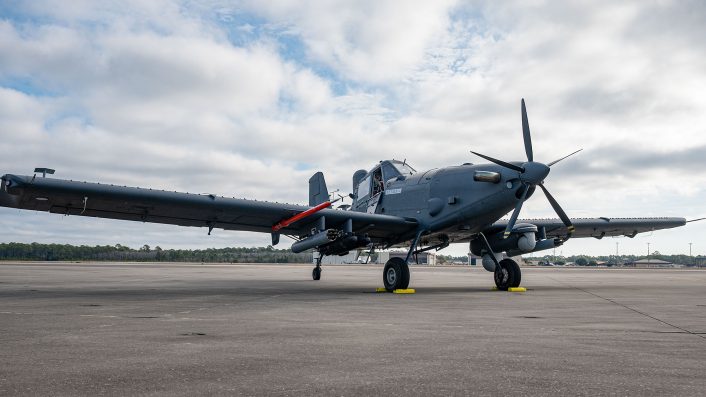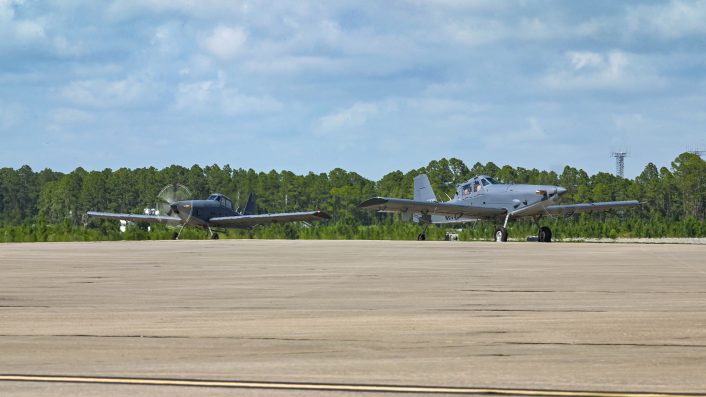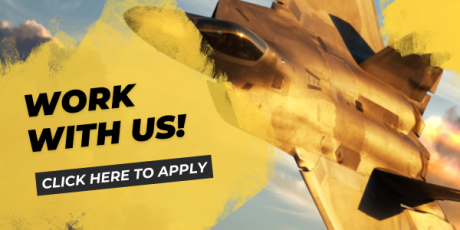After initially receiving AT-802Us to begin training, AFSOC has now taken delivery of the OA-1K in the final missionized configuration.
The first missionized L3Harris/Air Tractor OA-1K Skyraider II aircraft of the U.S. AFSOC (Air Force Special Operations Command) officially joined the fleet in a ceremony on Apr. 3, 2025, at Hurlburt Field,Florida. Described as “the start of a new era in aircraft modularity,” the delivery comes after AFSOC revealed the name chosen for the rugged and reliable OA-1K at the Air Warfare Symposium on Feb. 27.
The delivery ceremony also saw in attendance Lt. Col. Bill Buice, a 98-year-old retired A-1 Skyraider pilot who flew the plane from Jun. 1967 to Jul. 1968 during the Vietnam War, and survived being shot down during a mission. The Skyraider II is a derivative of the AT-802U, and was developed in response to the AFSOC’s Armed Overwatch program in 2022.
AFSOC previously received two AT-802U trainer aircraft at Hurlburt Field on Jun. 28, 2024, in a representative tail wheel configuration, to train crews for the missionized Armed Overwatch (OA-1K) variant. This was followed by the 137th Special Operations Wing of the Oklahoma ANG receiving its first AT-802U at Will Rogers International Airport in Oklahoma City on Jul. 29.
Additional aircraft from the order of 75 units will head from the production line to the Will Rogers Air National Guard Base, Oklahoma “in the coming months.” The base hosts the FTU (Formal Training Unit) for the OA-1K.

Modular, rugged and effective
Air Tractor and L3Harris beat Beechcraft AT-6 Wolverine, Embraer A-29 Super Tucano, and PZL’s M28B 1R Bryza for the $3 billion AFSOC deal. The Skyraider II aircraft are built in Olney, Texas, by Air Tractor and outfitted for the armed overwatch mission in Tulsa, Oklahoma, by L3Harris.
“Skyraider II represents not just a new platform, but a modular solution to our national security needs,” said Lt. Gen. Michael Conley, AFSOC commander. “It will redefine how we approach joint campaigning, crisis response and the evolving landscape of modern warfare.”
The OA-1K will initially supplement and then replace the U-28A Draco, a single-engine ISR platform based on the Pilatus PC-12, operated by the 1st Special Operations Wing (SOW) at Hurlburt Field and the 27th SOW at Cannon AFB, New Mexico.With the name being a tribute to the rugged and versatile A-1 Skyraider, which served from 1946 to the early 1980s, the tandem-seater Skyraider II is armed with a variety of air-to-ground weapons and electro-optical systems for CAS (Close Air Support), precision strike and manned ISR (Intelligence, Surveillance and Reconnaissance) roles.
In partnership w/ @airtractorinc, we’ve delivered the first OA-1K Skyraider II for @AFSpecOpsCmd. The Skyraider II brings advanced capabilities in close air support, precision strike & armed ISR for special ops personnel. https://t.co/GQjxCAka4X pic.twitter.com/nIg248LcVy
— L3Harris (@L3HarrisTech) April 3, 2025
The AT-802U is equipped with eight wing-mounted hardpoints, capable of carrying 500 lb (227 kg) munitions, plus two centerline stations for 1,000 lb (454 kg) weapons, giving it a total payload capacity of 8,000 lb (3,629 kg). The inner hardpoints are optimized for externally-mounted guns, with calibers ranging from .50 caliber to 20 mm. Other features include an armored Pratt & Whitney PT6A-67F engine and self-sealing fuel tanks.
“The Skyraider II reflects L3Harris’ commitment to delivering cost-effective, adaptable solutions that meet the evolving needs of the warfighter,” said Jon Rambeau, President of Integrated Mission Systems at L3Harris. “By leveraging our team’s innovation and expertise, we are providing special operations personnel with a versatile, mission-ready capability that supports operational requirements today and into the future.”
His words were echied by Jim Hirsch, President of Air Tractor: “Air Tractor is thrilled to be a part of this program. We stand ready to meet the future needs and to ensure this airframe aligns with the expectations of U.S. Air Force Special Operations Command.”

Use in a high-end war
Being derived from the proven AT-802 platform makes the Skyraider II a “dynamic aircraft” allowing “operators to adjust effects for required missions and create dilemmas for our adversaries across the spectrum of armed conflict,” said the service. However, the extent to which a slow, turboprop aircraft – albeit equipped with advanced weapons, avionics, communications, and sensors – can remain viable in high-end, non-permissive environments against peer adversaries remains an open question.
“This aircraft embodies the very essence of our command, it’s agile, it’s adaptable, and it’s always ready to deliver lethality,” said Conley. “AFSOC exists to accomplish the missions others can’t do. The Skyraider II is a testament to that enduring promise.”
The use of the new aircraft would be primarily linked to the special operation forces (SOF), able to orbit over the target area, at 200 NM from the base, in support to the operators for six hours with a payload of 6,000 lb. This would allow persistent cover for SOF operations in low-intensity environments, without the need to use larger and costlier aircraft. Irregular warfare and COIN (Counter-Insurgency) operations are another area where this aircraft excels, with those threats still prevalent in the Middle East.

The Skyraider is inherently ACE (Agile Combat Employment)-capable, thanks to the short takeoff and landing (STOL) capability and small support footprint which allow aircrews to co-locate with the disaggregated ground units they support. For instance, the heavily-armed Skyraider IIs could operate together with Pararescuemen (or “PJs”) and other SOF units transported by AFSOC CV-22B Ospreys.
A defining feature is the low operating costs, in the range of just hundreds of dollars per hour. Sustainability is another key factor, as the base aircraft is backed by an established global sustainment network, which adds to the ruggedness and reliability.
Two electro-optical turrets on a single pod under the left wing allow simultaneous use of different sensors for ISR, and even more could be used with a second pod installed on the right wing. Behind the cockpit, a fairing hosts additional systems, which include a robust suite of radios and datalinks providing multiple means for line-of-sight (LOS) and beyond line-of-sight (BLOS) communications.

Specific needs
The Senate Armed Services Committee meanwhile interviewed the Army’s Gen. Christopher Cavoli, the U.S. European Command (EUCOM) chief and Supreme Allied Commander Europe, and the Marine Corps’ Gen. Michael Langley, the Africa Command (AFRICOM) chief, for their defense authorization requests for 2026.
During the hearing, Sen. Mark Kelly of Arizona asked Langley about the “close air support gap” in the AFRICOM area of responsibility, amid a surge in activities by extremist outfits organizations. “As our focus continues towards large-scale combat operations in INDOPACOM and in Europe, I’m concerned that our defense modernization and optimization will trend towards those theaters, but away from other issues that we can’t ignore [including] the real threat of terrorism and gray-zone operations, especially in Africa,” Kelly said.
Kelly then asked Langley whether the OA-1K could meet a specific ISR-strike need for AFRICOM. Langley responded: “Every combat commander needs more ISR in support of our operations. I would take any additional ISR and any enhanced technologies that would add to the credibility and the lethality of our forces.”









